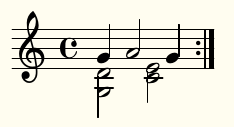Hello Everyone. This is my first post.
I’m trying to transcribe classical piano music to SuperCollider.
//////////////// Chopin Prelude in Em OP.28,No.4 /////////////////
(
SynthDef(\mdapiano, { |out=0, freq=440, gate=1,
vel= 100, decay= 0.8, release= 0.8, hard= 0.8,
velhard= 0.8, muffle= 0.8, velmuff= 0.8, velcurve= 0.8, stereo= 0.5,
tune= 0.5, random= 0.1, stret= 0.1, sus= 0|
var son = MdaPiano.ar(freq, gate, vel, decay, release, hard,
velhard, muffle, velmuff, velcurve, stereo,
tune, random, stret, sus);
FreeSelf(1-gate);
Out.ar(out, son );
}).add;
)
( // 1 2 3 4 5 6 7 8
var tNotes = [ 59,71, 71,72, 71,72, 71,72, 71,70, 69,71, 69,71, 69,71,69, 69,68,
// 9 10 11 12
67,69,71,74,72,64,69, 66,69, 66,71,69, 67,66,60,59,63,66,74,72,71,
// 13 14 15 16 17
71,72, 71,72, 71,72, 71,70,70,71,70,69,70,79,78,76, 76,75,84,75,75,76,79,71,
// 18 19 20 21 22 23
74,72,76,64,69,66,69, 66,71,69, 66,64, 64,66, 64,66, 64,\r,
// 24 25
[52,54,59,64],[51,54,59,63], [52,55,59,64],
];
// 1 2 3 4 5 6 7 8
var tDur = [ 3/4,1/4, 3,1, 3,1, 3,1, 3,1, 3,1, 3,1, 3,3/4,1/4, 3,1,
// 9 10 11 12
1,1/2,1/2,1/2,1/2,1/2,1/2, 3,1, 3,1/2,1/2, 1/2,1/2,1/2,1/2,1/2,1/2,1/3,1/3,1/3,
// 13 14 15 16 17
3,1, 3,1, 3,1, 3/4,1/4,1/2,1/8,1/8,1/8,1/8,1,3/4,1/4, 1/2,1/2,1/2,1/2,1/2,1/2,1/2,1/2,
// 18 19 20 21 22 23
1/2,1/2,1/3,1/3,1/3,3/2,1/2, 3,1/2,1/2, 15/4,1/4, 3,1, 3,1, 2,2,
// 24 25
2,2, 4,
];
// 1 2
var bNotes = [ \r, Pseq([[55,59,64]],8), Pseq([[54,57,64]],4),Pseq([[54,57,63]],4),
// 3
Pseq([[53,57,63]],4),Pseq([[53,57,62]],2),Pseq([[53,56,62]],2),
// 4
Pseq([[52,56,62]],4),Pseq([[52,55,62]],2),Pseq([[52,55,61]],2),
// 5 6
Pseq([[52,55,60]],4),Pseq([[52,54,60]],4), Pseq([[52,54,60]],4),Pseq([[51,54,60]],4),
// 7 8
Pseq([[50,54,60]],8), Pseq([[50,53,60]],4),Pseq([[50,53,59]],4), // bar 7,8
// 9 10
Pseq([[48,52,59]],2),Pseq([[48,52,57]],6), Pseq([[47,52,57]],2),Pseq([[47,51,57]],2),Pseq([[48,52,57]],4),
// 11 12
Pseq([[47,51,57]],4),Pseq([[48,52,57]],4), Pseq([[47,51,57]],2),Pseq( [\r], 6),
// 13 14
Pseq([[55,59,64]],8), Pseq([[54,57,64]],4),Pseq([[53,57,63]],4), // bar 13, 14
// 15
Pseq([[53,56,63]],2),Pseq([[53,56,62]],2),Pseq([[52,56,62]],4),
// 16
Pseq([[52,55,62]],2),Pseq([[52,55,61]],2),Pseq([[49,52,58]],2),Pseq([[48,52,57]],2),
// 17
[23,47],Pseq([[57,60,66,69]],3),[55,59,63,66],Pseq([[55,59,64]],3),
// 18
Pseq([[57,60,64]],2),45,[52,54,60],Pseq([[47,52,59]],2),Pseq([[48,52,57]],2),
// 19
Pseq([[47,52,59]],4),Pseq([[48,52,57]],4),
// 20
Pseq([[47,52,59]],4),Pseq([[47,51,59]],2),Pseq([[47,51,57]],2),
// 21
Pseq([[48,55]],4), Pseq([[48,58]],2),Pseq([[48, 52, 57]],2),
// 22
Pseq([[47,52,57]],2), Pseq([[47,52,56]],2),Pseq([[47,52,55]],4),
// 23 24 25
[46,48,55],\r, [35,47],[35,42,47], [30,42]
];
// 1-22 23 24 25
var bDur = [1, Pseq([1/2], 22*8), 2,2, 2,2, 4];
var instr = \mdapiano;
var bA = Pbind(\instrument, instr ,\midinote, Pseq(bNotes), \dur, Pseq(bDur),
\legato, 0.8, \vel, 60, \random, 0.0, \stret, 0.0);
var tA = Pbind(\instrument, instr ,\midinote, Pseq(tNotes), \dur, Pseq(tDur),
\legato, 0.8, \vel, 90, \random, 0.0, \stret, 0.0);
~score = Ppar([bA,tA]);
~score.play(TempoClock(50/60));
)
//////////////////////////
Here is my problem. In piano music,
a chord is held down simultaneously. But then
some voices can move while other notes are still held down.
i.e the chord notes have different durations? Does anyone
know an elegant way to deal with this?
thanks, Stewart


 )
)